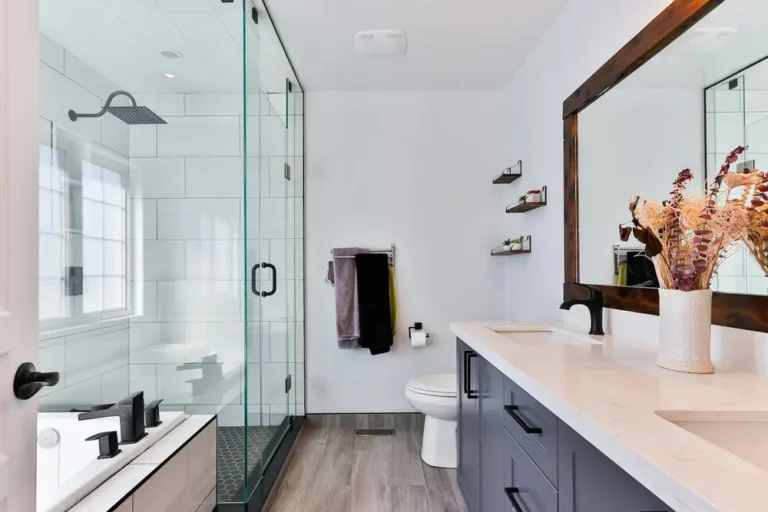7 Temporary Door Ideas – Best Solutions
There are several reasons why you might opt for a temporary door. It could be to demarcate a part of the house from the others for privacy, or maybe you want to introduce a bit of style into your home without renovating or making any permanent changes.
Whatever the reason, a temporary door is a unique way to touch up your home or workplace. It could be as simple as a curtain sheet or a bookcase and as extra as a privacy screen or a sliding barn door, depending on how easily it takes to remove the doors. So if you’re set on exploring your options for temporary door ideas, let’s dive right into it.
7 Temporary Door Ideas and How to Install Them
Below are temporary doors options you can try.
- Beaded curtain
This is one of the most temporary door ideas you can get, as you can easily remove them in events where they’re no longer needed. In addition to being easy to install, it is cost-friendly, attractive, and allows you to create space with minimal space, making them excellent options for use in small spaces.
Curtains perform both functional and decorative functions in allowing light to pass through them and their ability to embody seasonal feasts or special occasions with various fabric options.
Since curtains do not deface the walls in any way, they are a great choice for renters who don’t own a home yet. More so, curtains are available in various colors and styles; feel free to choose the ones that perfectly match your home decor.
How To Install a Curtain
- Attach a rod to the door frame or on the wall above it, depending on which is more convenient for you.
- Insert the curtain hanger into the curtain or hang the curtain on the curtain hanger.
- Place the curtain hanger on the rod. Ensure the curtain rod is properly hung, so it doesn’t fall off when someone passes under it.
2. Privacy screen
Privacy screens are available in metal, wood, and vinyl materials. They provide privacy without limiting visibility or airflow, making them excellent options in areas where you’d like the view of nature. If you’re attaching them to a door frame, ensure enough space for the door to open freely so that ease of movement is not affected.
Privacy screens are easy to install and a great option if you need something a little more permanent than beaded curtains but still temporary.
How To Install a Privacy Screen
- Measure the intended area for the privacy screen.
- Fit in the privacy screen and cut out any extras. Trim neatly and place in the door opening.
- Ensure the panel is properly attached and secured in place.
3. Vinyl Accordion Door
Vinyl accordion doors usually come in two pieces: one piece for the top door frame and the other for the bottom, including magnets for attachment. Nails and screws are not required for installation since vinyl accordion doors are magnetic, lightweight, and easy to move around.
Your door frame needs to be horizontal to install the vinyl accordion door. If it’s not, you’d need to adjust the hinges before installing the door. Ensure that the door fits your door frame perfectly before cutting out the bottom part.
If your vinyl accordion door doesn’t match the height of your door opening, you’d need to make additional cuts so that it fits your frame perfectly.
How To Install a Vinyl Accordion Door
- Measure your door opening and ensure it aligns with your vinyl accordion door.
- Thread the wheels on top of the door into the track and drill pilot holes for all openings on the track.
- Drill holes in the door frame. Ensure that the door jamb and front edge are in place.
- Align the door properly and screw it into place.
4. Tapestries and Wall Hangings
Tapestries are one of the ancient forms of woven textile materials. Unlike wall hangings, tapestries are usually not framed but hung from a rod attached to the top portion of the tapestry. Pick out the desired tapestry to cover an old doorway or to beautify a space.
How To Install a Tapestry
- Attach a strip or velcro to the wall.
- Press the tapestry to the strip and hold it in place for a few seconds.
- Attach a second strip to the opposite side of the tapestry and press it for a few seconds again.
- Use a hammer to nail the tapestry to the wall carefully. Do it for two edges or all four if you like.
- Ensure the tapestry is well-centered and visible from all angles.
5. Sliding Barn Doors
A sliding barn door is a nice option to conceal a room or provide privacy. It can perform decorative and functional purposes and be designed to suit one’s preference.
How To Install Sliding Barn Doors
- To install a sliding barn door, measure the width and length of your door opening. Then, cut the barn door to the size of your door frame.
- Place the barn door on your door frame and ensure it’s the perfect size before attaching it to the wall or door frame with screws or nails.
- You could also attach a stopper to the floor underneath your barn door, so the door doesn’t slide all the way open, as it could hit the wall or door frame and damage either of them.
6. Bookcase
A bookcase is another fantastic temporary door idea, especially for book lovers. It offers you the luxury of housing a mini library and posing as a door to enhance privacy and make your room attractive.
How To Install a Bookcase
- Measure the width and height of the area you’re looking to conceal and use that measurement in constructing your bookcase.
- For side panels of the bookcase, cut two pieces of wood, about half an inch smaller, on the two sides. This will help to cover any small gaps between the wall and the bookcase.
- For the top and bottom panels, the pieces of wood should be about 1-2 inches taller but of the same width as the bookcase.
- You can leave your bookcase without doors or attach sliding doors or a door with a handle to the front to allow easy opening and closing.
7. Shoji Sliding Doors
If you have a thing for the Japanese style of life, you can introduce it into your home with this temporary door style.
Shoji sliding doors are made of rice paper and can slide in and out effortlessly. They are lightweight, easy to install, and can be used to separate two rooms. They also provide privacy and add a calming effect with a touch of beauty to your space.
How To Install a Shoji Sliding Door
- Choose your desired color and pattern for the door.
- Create a square opening in the door frame.
- Attach valance boards to the ceiling or door frame and screw them in.
- Screw the overhead tracks (with the rollers inside) to the upper edge of the door opening and attach the other part of the hardware to the top edge of the door.
- Hang the shoji sliding doors. In the middle of the doors, install three guide tabs on the floor where the doors overlap.
Conclusion
A temporary door is a fantastic option if you want to spice up your space without having to do too much, allowing you to blend temporary and beauty into one easily.
Most temporary door options are cost-friendly, simple to install, and easy to operate. It’s unlikely that you’ll need the services of a handyman or professional during installation. However, if you’re not too confident in your ability to DIY, then feel free to request the services of a professional.
Note that curtains, bookcases, and tapestries are better temporary door options to go with if you’ll be moving out soon or just need something for the moment. All in all, explore your home decor with the various temporary door options and appreciate the gift of style and beauty.




